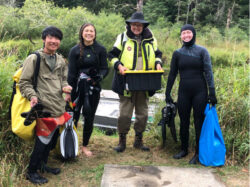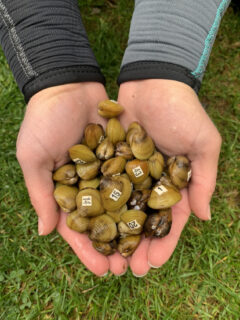by Allison Simmons, Alexandra Tyler, and Nathaniel Iwakoshi, Walla Walla University undergraduate students; and David Cowles, PhD., Walla Walla University Professor of Biology
During the summer of 2021, Allison Simmons, Alexandra Tyler, Nathaniel Iwakoshi, and David Cowles studied the population dynamics of an early-stage invasion of Corbicula fluminea, the Asian clam, in Lake Ozette, Washington. This research was recognized and funded in part by a 2021 Special Group Award from the Washington Lakes Protection Association.
Invasive species pose a major threat to freshwater lakes and their inhabitants in the Pacific Northwest. One of the most pervasive invaders is Corbicula. Despite its rapid spread across North America, it has not been well studied in the Pacific Northwest.
In 2018, this species was discovered in Lake Ozette and has been spreading rapidly, potentially putting the lake’s inhabitants, including several vulnerable species of freshwater mussels, endangered sockeye salmon, and the threatened water lobelia, at risk. Our research aimed to better understand the impact of this invasive species on the lake and its inhabitants by examining key aspects of its biology such as growth rates and population density.
To determine the distribution and abundance of Corbicula in Lake Ozette, we surveyed the shoreline, recording the conditions every 100 meters out to a depth of 1 meter. Additionally, we established microcosms for Corbicula growth in June of 2020 and 2021. (Microcosms are simplified ecosystems created to help study natural processes.) In August 2021, we retrieved the microcosms and were able to collect data on the growth of Corbicula over time.
Our research resulted in eight key findings:
1. Corbicula’s population density is much higher than that of the native species.
2. The spread of Corbicula down Lake Ozette seems to be more highly correlated with the length of the shoreline than with direct pelagic distance down the lake.
3. The shell length of Corbicula decreases from north to south in Lake Ozette.
4. Older populations are more dense but younger populations can still be dense.
5. Smaller clams grow faster and there is little growth past 25-30 mm long.
6. Corbicula grow twice as much in a full year as they do over one summer.
7. The wet mass of Corbicula increases nearly at the third power of its shell length.
8. Corbicula’s habitat overlap with native species appears to be the greatest with water lobelia and Anodonta mussels, so it may impact them most strongly.
Overall, this research provides important information about the impact of Corbicula on freshwater lakes and their inhabitants in the Pacific Northwest. These findings can help guide management strategies aimed at reducing the impact of this invasive species on native species and preserving the biodiversity of freshwater lakes.











